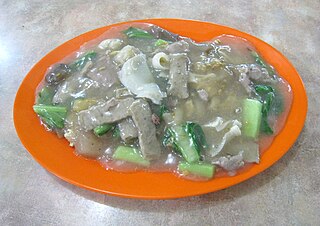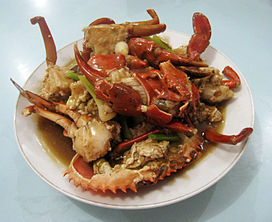
Teochew cuisine, also known as Chiuchow cuisine, Chaozhou cuisine or Teo-swa cuisine, originated from the Chaoshan region in the eastern part of China's Guangdong Province, which includes the cities of Chaozhou, Shantou and Jieyang. Teochew cuisine bears more similarities to that of Fujian cuisine, particularly Southern Min cuisine, due to the similarity of Teochew's and Fujian's culture, language, and their geographic proximity to each other. However, Teochew cuisine is also influenced by Cantonese cuisine in its style and technique.

Indonesian cuisine is a collection of various regional culinary traditions that formed in the archipelagic nation of Indonesia. There are a wide variety of recipes and cuisines in part because Indonesia is composed of approximately 6,000 populated islands of the total 17,508 in the world's largest archipelago, with more than 1,300 ethnic groups.

Malay cuisine is the traditional food of the ethnic Malays of Southeast Asia, residing in modern-day Malaysia, Indonesia, Singapore, Brunei, Southern Thailand and the Philippines as well as Cocos Islands, Christmas Island, Sri Lanka and South Africa.

Fried rice is a dish of cooked rice that has been stir-fried in a wok or a frying pan and is usually mixed with other ingredients such as eggs, vegetables, seafood, or meat. It is often eaten by itself or as an accompaniment to another dish. Fried rice is a popular component of East Asian, Southeast Asian and certain South Asian cuisines, as well as a staple national dish of Indonesia. As a homemade dish, fried rice is typically made with ingredients left over from other dishes, leading to countless variations. Fried rice first developed during the Sui dynasty in China.

Chinese Indonesian cuisine is characterized by the mixture of Chinese with local Indonesian style. Chinese Indonesians, mostly descendant of Han ethnic Hokkien and Hakka speakers, brought their legacy of Chinese cuisine, and modified some of the dishes with the addition of Indonesian ingredients, such as kecap manis, palm sugar, peanut sauce, chili, santan and local spices to form a hybrid Chinese-Indonesian cuisine. Some of the dishes and cakes share the same style as in Malaysia and Singapore, known as Nyonya cuisine by the Peranakan.

Nasi goreng, Malay lit. 'fried rice', is a Southeast Asian rice dish with pieces of meat and vegetables added. It can refer simply to fried pre-cooked rice, a meal including stir fried rice in a small amount of cooking oil or margarine, typically spiced with kecap manis, shallot, garlic, ground shrimp paste, tamarind and chilli and accompanied by other ingredients, particularly egg, chicken and prawns. There is also another kind of nasi goreng which is made with ikan asin which is also popular across Indonesia. Nasi goreng is sometimes described as Indonesian stir-fried rice, although it is also popular in Southeast Asia. Beyond the Malay Archipelago, it has gained popularity through Indonesian influence in Sri Lanka and via Indonesian immigrant communities in Suriname and the Netherlands. It is distinguished from other Asian fried rice recipes by its aromatic, earthy and smoky flavor, owed to generous amount of caramelised sweet soy sauce and powdered shrimp paste, and the taste is stronger and spicier compared to Chinese fried rice.

Chilli crab is a Southeast Asian seafood dish that is widely associated with the cuisines of both Malaysia and Singapore. The widely known version of chili crab today could be traced back to the 1950s in Malaysia and Singapore. Mud crabs are commonly used and are stir-fried in a semi-thick, sweet, and savoury tomato-and-chilli-based sauce.

Padang dish or Minangkabau dish is the cuisine of the Minangkabau people of West Sumatra, Indonesia. It is among the most popular cuisines in Maritime Southeast Asia. It is known across Indonesia as Masakan Padang after Padang, the capital city of Western Sumatra province. It is served in restaurants mostly owned by perantauan (migrating) Minangkabau people in Indonesian cities. Padang food is ubiquitous in Indonesian cities and is popular in neighboring Malaysia and Singapore.

Cap cai, sometimes spelled cap cay, is the Hokkien-derived term for a popular Chinese Indonesian and Peranakan stir fried vegetable dish that originates from Fujian cuisine.

Kwetiau goreng is an Indonesian style of stir fried flat rice noodle dish. It is made from noodles, locally known as kwetiau, which are stir-fried in cooking oil with garlic, onion or shallots, beef, chicken, fried prawn, crab or sliced bakso (meatballs), chili, Chinese cabbage, cabbages, tomatoes, egg, and other vegetables with an ample amount of kecap manis. In Asia, kwetiau is available in two forms, dried and fresh. Its recipe is quite similar to another Chinese Indonesian favourite, mie goreng, with the exception of replacing yellow wheat noodles for flat rice noodles.

Mie ayam, mi ayam, or bakmi ayam is a common Indonesian dish of seasoned yellow wheat noodles topped with diced chicken meat. It is derived from culinary techniques employed in Chinese cuisine. In Indonesia, the dish is recognized as a popular Chinese Indonesian dish, served from simple travelling vendor carts frequenting residential areas, humble street-side warung to restaurants.

Bumbu is the Indonesian word for a blend of spices and for pastes and it commonly appears in the names of spice mixtures, sauces and seasoning pastes. The official Indonesian language dictionary describes bumbu as "various types of herbs and plants that have a pleasant aroma and flavour — such as ginger, turmeric, galangal, nutmeg and pepper — used to enhance the flavour of the food."

Crab in Padang sauce or Padang crab is an Indonesian seafood dish of crab served in hot and spicy Padang sauce. It is one of the two most popular ways that crab is served in Indonesia, commonly found in coastal cities with abundant seafood, such as Padang, Jakarta, Medan, Surabaya, Makassar and Cirebon. Its closest analogue probably is chili crab; however, Padang crab uses richer spices.

Stir-fried water spinach is a common Asian vegetable dish, known by various names in Asian languages. Water spinach is stir-fried with a variety of vegetables, spices, and sometimes meats. It is commonly found throughout East, South and Southeast Asia; from Sichuan and Cantonese cuisine in China, to Indonesian, Burmese, Cambodian, Filipino, Malaysian, Singaporean, Taiwanese, and Vietnamese cuisine; to Sri Lankan cuisine and Bengali cuisine in South Asia.

Beef kway teow or beef kwetiau is a Maritime Southeast Asian dish of flat rice noodles stir-fried and topped with slices of beef or sometimes beef offal, served either dry or with soup. The dish is commonly found in Southeast Asian countries, especially Singapore and Indonesia, and can trace its origin to Chinese tradition. It is a popular dish in Singaporean cuisine and among Chinese Indonesians, where it locally known in Indonesian as kwetiau sapi.

Tauge goreng is an Indonesian savoury vegetarian dish made of stir-fried tauge with slices of tofu, ketupat or lontong rice cake and yellow noodles, served in a spicy oncom-based sauce. Tauge goreng is a specialty of Jakarta and Bogor city, West Java, Indonesia. It is usually sold as street food using pikulan or gerobak (cart) by street vendors. It is a popular street food in Indonesia, especially in Jakarta, and Greater Jakarta areas, including Bogor, Depok, Tangerang and Bekasi.

Ifumi is an Indonesian crispy deep fried thick noodle dish, popular in Maritime Southeast Asia, served in a thick savoury sauce with pieces of meat or seafood and vegetables. The dishes are to be served hot while the noodles are still crisp until the noodles are softened by the sauce and are ready to be eaten. The dish is one of the most popular noodle dishes in Chinese Indonesian cuisine. The type of noodle being used in this dish is the thick yi mein noodle, hence the origin of its name. It is quite similar to mie kering noodles from Makassar.

Mala xiang guo, roughly translated into English as "spicy stir-fry hot pot", is a Chinese dish prepared by stir frying. Strongly flavored with mala, it often contains meat and vegetables, and has a salty and spicy taste. The preparation process involves placing the required ingredients in the pot, stir frying and adding seasoning. In restaurants, customers usually choose the ingredients by themselves before the chef prepares the dish.


















